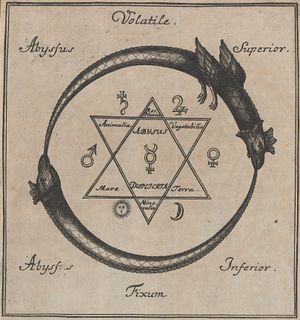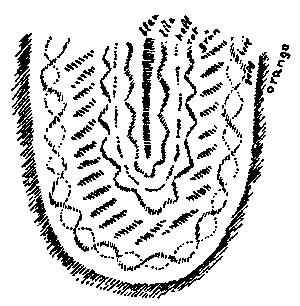Secret of the Abyss

One abyss the other calls out,
Together they make a hard strife:
The fleeting shall become quite fixed,
Water and vapour turn to earth.
Heaven itself must be earthly,
Or else no life will enter the earth.
The highest shall be the lowest,
The lowest shall become the highest fine.
That which is fixed shall become quite fleeting,
The earth shall be water and vapour.
The earth must fly up to the sky,
Heaven must crawl into the centre of the earth.
Thus heaven and earth must be reversed,
Let the lowest become the highest.
The fleeting dragon kills the fixed one,
The fixed one kills the fleeting one.
So it must come to be revealed in the day,
The quintessence, and what it can do.
The Secret of the Abyss is the first of the Seven Secrets of Life Rudolf Steiner spoke of. Since this secret is connected with the first stage of each seven-stage path of evolution, the first of the seven great cosmic stages of world evolution, Old Saturn, corresponds to it. During Earth evolution, which is itself the fourth great cosmic stage of evolution, again all periods are particularly affected which are on the first stage. This concerns in particular the polar time and, on a smaller scale of cultural epochs, the ancient Indian times.
„Man has entered into development as a universal being. He then becomes a special being. At first he separated himself as a single sphere from a general sphere. These individual human spheres went through the various transformations. From one of the later transformations arose the so-called etheric double body. This stage of the first separation from the All-being is called the "sinking of consciousness into the abyss". This is reached in the physical stage of the first planet. It is preceded and followed by 24 stages. The middle stage, the 25th, is the densest. The physical disposition came into being as a rough physical sphere. The earth then resembled our ether or the light matter of our present earth, and after the fall of consciousness into the abyss had the form of a kind of mulberry.“ (Lit.:GA 89, p. 144ff)
Gnosis
Bythos (Greek: βυθός), depth or abyss, is what some Gnostic schools, especially the Valentinians, call the invisible, incomprehensible, unnameable primordial beginning, the "unknown God", the source of all being, the perfect Aion (Greek: αἰών "aeon"), from whom the world took its origin[1]. Other Gnostic schools use expressions such as proarché (Greek: προαρχή "before the beginning") or similar.
The Abyss as an Experience of the Spiritual Disciple
„Whoever does not acquire an awareness of the fact that there is a yawning abyss between our stay in the sense fields with which we have to live during our earthly existence between birth and death, that there is a yawning abyss between our stay in the sense fields and that which is in the spiritual fields, whoever does not acquire a due awareness of this, cannot acquire true, real knowledge. For with this consciousness alone can man enter into true, real knowledge. He does not need to become clairvoyant, although the knowledge of the spiritual world comes from true clairvoyance, but he must acquire an awareness of that which is there as a reminder at the yawning abyss of the secrets of space, the secrets of time, the secrets of the human heart itself. For whether we go out into the expanses of space, the abyss stands there; whether we wander out into the turns of time, the abyss stands there; whether we go into our own heart, the abyss stands there.
And these three abysses, they are not three abysses, they are one abyss.“ (Lit.:GA 270a, p. 9)
„Just when man feels the beauty, grandeur and sublimity of the physical-sensuous world and feels that he cannot find himself there with the best that he himself is, then he is urged more and more towards that from which all esoteric contemplation must actually proceed: He is urged towards that abyss beyond which can only lie that from which man has his origin; he is urged towards that abyss where he must really see the boundary between the sense world and the spiritual world; he is urged towards that abyss which at a certain point shows him something like a bridge which leads across into a quite different world, at the starting point of which lies the threshold of knowledge and the spiritual world.
And what I have to tell you, my dear friends, are the messages of that figure which in all esotericism is called the Guardian of the Threshold [...]
Why is this Guardian of the Threshold standing there? This Guardian of the Threshold stands there for the reason that real knowledge can only be attained if we approach it with the right, good preparation, an internalised attitude and true striving for knowledge. True striving for knowledge is nothing theoretical. True striving for knowledge is only attained when the soul rises above that which the world of the senses offers.
He who approaches this knowledge too early, unprepared, that is, not with the right attitude, will not attain this knowledge in the right way. He will produce harmful effects for himself and for the world.“ (Lit.:GA 270c, p. 163f)
The Abyss between the Etheric Body and the Physical Body
At the moment of waking up, when I and astral body dive back into the abiding body, we cross the abyss between the etheric body and the physical body. This experience is clearly different from the dream consciousness filled with life reminiscences.
„Mere dreaming takes place in such a way that it is filled with life reminiscences. What happens at the moment of waking up are not life reminiscences. They can be very well distinguished from life reminiscences, these flooding thoughts. They can be translated into the language of ordinary consciousness, but they are essentially strange thoughts, thoughts which we cannot otherwise experience unless we grasp them in the moment which is made possible either by spiritual-scientific training in us, or precisely in this moment of waking.
What do we actually grasp there? Well, we have penetrated with our I and our astral body into the etheric body and into the physical body. What is experienced in the etheric body, however, is experienced in such a way that it is dreamlike. And by learning to observe this subtly in the presence of the spirit, as I have indicated, one learns to distinguish between this passing through the etheric body, in which the reminiscences of life occur in a dream-like manner, and then, before full awakening, before the impressions which the senses now have after awakening, being placed in a world which is certainly a world of weaving thoughts, but which is not experienced in the same way as the dream thoughts, where one knows exactly that one has them subjectively within oneself. The thoughts I am referring to now present themselves quite objectively to the intruding I and astral man, and one notices quite clearly: one must pass through the etheric body; for as long as one passes through the etheric body, everything remains dreamlike. But one must also pass through the abyss, the intermediate space - I should like to say, if I express myself rather inaccurately, but perhaps thereby more clearly - the intermediate space between the etheric body and the physical body, and then slips into the full etheric-physical by waking up and the outer physical impressions of the senses are there. As soon as one has slipped into the physical body, the outer physical sense impressions are there. What we experience there in the way of objective thought weaves, takes place between the etheric body and the physical body. We must therefore see in it an interaction of the etheric body and the physical body. So that we can say, if we draw schematically: If, for instance, this represents the physical body (orange), that the etheric body (green), then we have the living weaving of physical body and etheric body in the thoughts which we grasp there, and by way of such an observation one then comes to the realisation that between our physical and our etheric body, regardless of whether we are awake or asleep, processes are always taking place which actually consist in weaving thought-being, which are weaving thought-being between our physical body and our etheric body (yellow). So that we have now grasped the first element of soul life objectified. We see in it a weaving between the etheric body and the physical body.

This weaving thought-life does not actually come to our consciousness in the waking state as it is. It must be grasped in the way I have described.“ (Lit.:GA 207, p. 50f)
Literature
- Kurt Rudolph: Die Gnosis. Wesen und Geschichte einer spätantiken Religion, Vandenhoeck & Ruprecht, Göttingen 2005 ISBN 3-525-52110-3
- Rudolf Steiner: Bewußtsein Leben Form, GA 89 (2001), Berlin, 29. Oktober 1904 English: rsarchive.org German: pdf pdf(2) html mobi epub archive.org
- Rudolf Steiner: Anthroposophie als Kosmosophie – Erster Teil, GA 207 (1990), ISBN 3-7274-2070-7 English: rsarchive.org German: pdf pdf(2) html mobi epub archive.org
- Rudolf Steiner: Esoterische Unterweisungen für die erste Klasse der Freien Hochschule für Geisteswissenschaft am Goetheanum. Band I, GA 270a (1999) English: rsarchive.org German: pdf pdf(2) html mobi epub archive.org
- Rudolf Steiner: Esoterische Unterweisungen für die erste Klasse der Freien Hochschule für Geisteswissenschaft am Goetheanum. Band III, GA 270c (1999) English: rsarchive.org German: pdf pdf(2) html mobi epub archive.org
 |
References to the work of Rudolf Steiner follow Rudolf Steiner's Collected Works (CW or GA), Rudolf Steiner Verlag, Dornach/Switzerland, unless otherwise stated.
Email: verlag@steinerverlag.com URL: www.steinerverlag.com. Index to the Complete Works of Rudolf Steiner - Aelzina Books A complete list by Volume Number and a full list of known English translations you may also find at Rudolf Steiner's Collected Works Rudolf Steiner Archive - The largest online collection of Rudolf Steiner's books, lectures and articles in English. Rudolf Steiner Audio - Recorded and Read by Dale Brunsvold steinerbooks.org - Anthroposophic Press Inc. (USA) Rudolf Steiner Handbook - Christian Karl's proven standard work for orientation in Rudolf Steiner's Collected Works for free download as PDF. |
References
- ↑ Rudolph, p. 71
